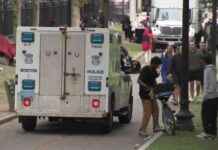Everyone was nervous.
For the Kenwood Academy Jazz Band, director Gerald Powell and even Jason Moran — a widely admired jazz pianist and MacArthur Fellow — were fully aware of how much they had taken on.
Though the Kenwood band performed the world premiere of Moran’s "Looks of a Lot" in Orchestra Hall at Symphony Center in May 2014, this time was different: The young musicians were heading to the nation’s capital to play the epic work at the Kennedy Center, where Moran serves as artistic director for jazz.
Some of the Kenwood students never had been on a plane. Even Powell, an accomplished Chicago jazz musician, never had set foot in the Kennedy Center, let alone performed on one of its stages.
Could the young musicians, most of whom hadn’t been involved in the 2014 performance, match the earlier triumph at an even more prominent venue?
Could Moran make this intricately staged composition — featuring his celebrated Bandwagon trio, more than 30 students and movable set pieces by Chicago artist Theaster Gates — survive a new environment?
And could a Washington audience relate to "Looks of a Lot," which explores the affect of Chicago’s widely reported violence but also holds out hope, faith and affirmation?
The answers would come during the course of three intense days last week, as the Kenwood band, teachers and chaperoning parents would join forces with Moran during a dizzying itinerary.
Here’s what happened:
7 p.m., Feb. 22: Students on screen
The Kenwood musicians and a Washington audience converge on the Kennedy Center Jazz Club to watch "Kenwood’s Journey," an hourlong, Tribune-produced documentary about the 2014 world premiere.
During the lively panel discussion that follows, Moran reveals how the students inspired him the last time around.
"How they played … gave me more confidence that the songs were actually decent," he says.
Maybe so, but the kids had been on edge.
"I became a nervous Nellie," says Kenwood trombonist Alyssa Younger, 18, one of three Kenwood students who played in the original Chicago concert.
"I’m going to admit this now: In the middle of the (Orchestra Hall) performance, I stopped playing. I got really nervous. I didn’t know what to do. I didn’t want to mess up the whole performance."
Younger’s confession draws not admonition but praise from the man whose music she had attempted to perform.
"That’s amazing that you stopped, because that’s a brilliant thing to do," responds Moran.
"It’s a really mature thing to do. You know how many professional musicians won’t take the horn out of their mouths?"
Still, Moran cautions Younger and all the students in the house about what awaits them two nights from now.
"Friday is not promised," he says, referring to the forthcoming concert.
"I try in rehearsals to really figure out what needs to happen. I don’t want no mystery by the time it gets to Friday.
"I want the audience to have the mystery. I want us to know, though."
7:55 a.m., Feb. 23: African American History museum
Moran and Kennedy Center staff have arranged for the Kenwood band to take a guided tour of the National Museum of African American History & Culture before the doors open to the public in the morning.
So the students take the Metro to the museum, where they behold a narrative of tragedy and triumph dating to 1400.
They read statistics on the millions of Africans enslaved, observe amulets resembling shackles and behold the bible of slave-rebellion leader Nat Turner. They’re warned about the graphic nature of the contents of one room, which contains photos of lynchings and the white hoods of Ku Klux Klansmen.
MOST READ ENTERTAINMENT NEWS THIS HOUR
Then the students move on to an exhibition on the "March to Montgomery" and watch historic footage of civil rights protesters suffering police beatings. Nowhere, though, do the young musicians become quieter or linger longer than in a small, darkened room holding the restored casket of Emmett Till, the Chicago 14-year-old slaughtered in 1955 by vigilantes in Mississippi for allegedly having whistled at a white woman.
"It was emotionally heavy," says Kenwood bass guitarist Steven Bowman, 15, a sophomore.
"It was pretty emotionally draining," observes Kenwood alto saxophonist Samuel Reynolds, 15, a freshman. "It was kind of depressing."
Still, the students connect the bittersweet history on display at the museum — which includes an exhibit celebrating African-American musical achievement — to their own lives.
"We saw struggles and slavery and all of this," adds Reynolds.
"And now there’s a predominantly black band coming from the South Side of Chicago (to) perform in Washington, D.C., in the Kennedy Center.
"That’s what it really is about for me. Showing how far we’ve come."
2 p.m., Feb. 23: First rehearsal
The students take their places on the bandstand of the Kennedy Center’s Eisenhower Theater, and Moran is eager to see them.
"How was the trip this morning?" he says, asking about the museum outing.
Everyone claps and many say "thank you."
Then Moran sets to work, standing amid a stage crowded with bandstand, concert grand piano, Gates’ props, Moran’s Bandwagon, guest soloists Ken Vandermark on reeds and Katie Ernst on bass/vocals, director Powell, assistant director Bethany Pickens and various stagehands.
"It’s a lot smaller," Moran says to the kids, comparing the stage to Orchestra Hall, "and it’s a lot more people.
"The thing about working in the theater is that you have to be patient with everybody," he adds. "And you’re showing great patience."
Boldly, some of the band members offer Moran suggestions on how to improve his own piece, and he adopts many of their ideas.
"Really great rehearsal," he says, as dinner time approaches.
"Tomorrow we’ll put it all together. … And then we’ll be ready for the show."
The rehearsal "went well," bass guitarist Bowman, who played in the Chicago production, says later.
"It’s definitely a different feeling than at Symphony Center, because you’re like in a different state," he adds, referring not to geography but to psychological space.
"I felt like I’d gotten to a higher level of music playing."
Sixteen-year-old trumpeter Jordan Gallon, a junior, initially finds Moran intimidating.
"I was really nervous at first — man, he looks like he means business," she says.
But then she realizes, "He’s really calm. He’s open to new ideas and to us. … It’s really a lot of nerves and emotions, but they’re all good nerves and good emotions."
The Kenwood Academy Jazz Band prepares to take Jason Moran’s ‘Looks of a Lot’ to the Kennedy Center, in Washington, on Friday. The trip could be transformative.
(Zbigniew Bzdak)
2 p.m., Feb. 24: Final rehearsal
While the band plays Moran’s opus, he sits at the piano and sways to the beat, sometimes taking out his camera to videotape the proceedings for himself.
As the music gathers momentum, he offers encouragement and suggestions.
"We’re warming the building up now," he says, as the kids blast away.
7:21 p.m., Feb. 24: The storm before the storm
All at once, the boys in the Kenwood band burst out of their Kennedy Center dressing room looking as if they’d stepped off the pages of GQ magazine. They’re wearing sharp, navy blue blazers with the Kenwood crest out front, powder-blue shirts, red-white-and-blue bow ties, tan pants and bright red sneakers.
Something about putting on that uniform energizes them, for they’re dancing, chanting, shouting, taking selfies and, ultimately, bounding upstairs to the green room.
Several gather around the piano and begin singing "Lift Every Voice and Sing," an anthem of the civil rights movement often dubbed the Black National Anthem. Moran shows up dressed in a Kenwood shirt, bow tie and blue knit suit, looking less the progenitor of the evening than another musician in the band.
Kennedy Center President Deborah Rutter, who was president of the Chicago Symphony Orchestra when she and colleague Jim Fahey commissioned Moran to write his magnum opus, comes backstage to meet and greet.
"Can you believe it has come this far?" she says to me.
8 p.m., Feb. 24: Show time
A hush falls backstage as the students file toward their seats on the bandstand.
Then Rutter steps into the spotlight to say a few words to the audience. She tells of how she and Fahey had asked Moran to consider creating "a piece that might be about the epidemic of gun violence in Chicago."
A few moments later she gets to the crux of the matter.
"Now there’s another aspect that I think you should know about," she says to the crowd.
"When the piece was presented in 2014, the theme of gun violence unfortunately had had an impact on that performance. Because one of the truly brilliant young artists, a 15-year-old guitarist, was shot and killed two weeks before the performance."
Rutter’s voice trembles a bit, though not quite as much as when she introduced the work May 30, 2014, in Orchestra Hall, the killing of Aaron Rushing still fresh in the city’s psyche.
"So, at that time, we dedicated the performance to Aaron Rushing. And I think that Aaron Rushing is here with us tonight as well.
"So let’s all think about what this means."
Rutter leaves the stage, and Moran begins playing solemn chords on the pump organ he used in the Chicago performance. After setting a mood of mystery, he walks slowly to the piano, improvising with his trio a suite of pieces culminating in a pungent blues.
Then Kenwood’s drum line marches onto the stage, the crack of sticks on skins and the rumble of mallets on bass drums rocking the house.
Seventeen-year-old trumpeter Andre Franks, a senior, stands up to play the first and most pivotal instrumental solo of the night, in Roy Eldridge’s classic ode to Chicago, "Wabash Stomp." Franks never has gotten through the piece flawlessly in rehearsal, but this time he not only nails it but riffs on it, swinging rhythms and inserting alternate notes no one had heard from him before.
He clearly has found his voice, as have his colleagues, who are tearing into this music. They bring sorrow to the dirgelike passages Moran has created for them to play as they march around a sculpture that suggests a casket. And they conjure palpable optimism in Moran’s climactic "Shoulder to Shoulder," its quotations from Elgar’s "Pomp and Circumstance" March No. 1 (played at graduations everywhere), pointing to the future for these students.
Through it all, the Washington audience applauds, yells, whistles and rises to its feet, especially at the grand finale, when all the students shout, in unison: "KEN-WOOD… Jaaaaazzz."
Moran brings his young colleagues to the lip of the stage for a curtain call, the students exulting in the moment.
"Give it up for the Kenwood band!" Moran shouts into the microphone."I want to thank them, really, from the bottom of my heart. This is not an easy thing to do."
Then Moran makes a proclamation: "We’re going into the studio in late May to make a recording of this," drawing cheers all around.
The performers march off stage, euphoric.
9:50 p.m., Feb. 24 — The afterglow
Musicians, parents, siblings, friends and others swarm the green room, hugs and cheers and high-fives in abundance.
No one seems more relieved than trumpeter Franks, who somehow had sailed through a solo that bedeviled him for months.
"I was shaking," he says, reflecting on his triumph. "Because I was thinking even last night: I don’t want to mess up, I don’t want to mess up.
"When I got out there, everybody encouraged me and told me: You got it. … I don’t know. It was just a miracle."
So what exactly happened out there?
"Well, I know one thing — we made history," says Moran, speaking in his dressing room as he unwinds from three extraordinary days.
"Because we brought an energy that is necessary, an energy that is necessary to experience not only as a performer, but also, I think for an audience to experience it, too.
"There’s a universal truth in watching the youth," Moran adds. "There’s an inherent joy in watching children succeed.
"And they really performed at an outstanding level, and it was apparent by the hollers from the audience.
"I said I’m going to record this piece. I don’t know how I’m going to do it, but we are going to make that happen.
"They now can go home and say: We did this. It’s true and it’s real and it happened and it’s history."
And with a recording session a few months away, there’s more history yet to be made.
Howard Reich is a Tribune critic.
hreich@chicagotribune.com
Twitter @howardreich
RELATED STORIES:
Kenwood Academy Jazz Band’s Journey: The road to Kennedy Center
Part One: Kenwood jazz band journeys to Symphony Center stage
Part Two: Kenwood band members grieve for slain guitarist, 15
Part Three: Voices of Kenwood: Taking the stage
Check out the latest movie reviews from Michael Phillips and the Chicago Tribune.
Check out reviews for all new music releases from Tribune music critic Greg Kot.
Our editors found this article on this site using Google and regenerated it for our readers.








